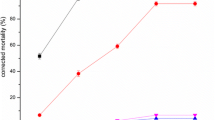Abstract
In this paper, the effect of age, humidity, and temperature on the conidial survival of Entomophthora muscae was evaluated. E. muscae was obtained from Musca domestica in a dairy in Itatiba (São Paulo, Brazil) and maintained in the laboratory by continuous passage through flies. Furthermore, the ability of conidia to infect flies at three temperatures (17, 21, and 27 °C), four ages of conidia (12, 72, 96, and 154 hours) and two humidities (100 and 60% RH) was evaluated. The temperature of 21 °C was the most favorable for the infection of house flies. Humidity was a cause of variation at 27 °C when the conidia were up to 12 hours old, but had no effect at lower temperatures. Conidia held at 100% RH and aged 72 hours caused no infection at 17 °C, but were infective at 21 °C. In the present study, conidia retained viability much longer than previously observed. Finally, the effect of humidity, temperature, and conidial age is discussed.
Similar content being viewed by others
References
Baird, R.B., 1957. Notes on a laboratory infection of Diptera caused by fungus Empusa muscae Cohn. Can. Entomol. 89: 432–435.
Berisford, Y.C. and C.H. Tsao, 1974. Field and laboratory observations of an entomogenous infection of the adult seedcorn maggot, Hylemya platura (Diptera: Anthomyiidae). J. Ga. Entomol. Soc. 9: 104–110.
Bellini, R., B.A. Mullens and J.B. Jespersen, 1992. Infectivity of two members of Enthomophthora muscae complex (Zygomycetes: Entomophthorales) for Musca domestica (Dip.: Muscidae). Entomophaga 37: 11–19.
Brobyn, P. and N. Wilding, 1983. Invasive and developmental processes of Entomophthora muscae infecting house flies (Musca domestica). Trans. Br. Mycol. Soc. 80: 1–8.
Carruthers, R.I. and D.L. Haynes, 1985. Laboratory transmission and in vivo incubation of Entomophthora muscae (Entomophthorales: Entomophthoracae) in the onion fly Delia antiqua (Diptera: Anthomyidae). J. Inv. Pathol. 45: 282–287.
Carruthers, R.I. and D.L. Haynes, 1986. Temperature, moisture, and habitat effects on Entomophthora muscae (Entomophthorales: Entomophthoracea) conidial germination and survival in the onion agroecosystem. Environ. Entomol. 15: 1154–1160.
Carruthers, R.I., D.L. Haynes and D.M. MacLeod, 1985. Entomophthora muscae (Entomophthorales: Entomophthoracae) mycosis in the onion fly, Delia antiqua (Diptera: Anthomyiidae). J. Invert. Pathol. 45: 81–93.
Eilenberg, J., 1987. The culture of Entomophthora muscae (C) Fres. in carrot flies (Psila rosae F.) and effect on the pathology of the fungus. Entomophaga 32: 425–435.
Geden, C.J., D.C. Steinkraus and D.D. Rutz, 1993. Evaluation of two methods for release of Entomophthora muscae (Entomophthorales: Entomophthoraceae) to infect house flies (Diptera: Muscidae) on dairy farms. Environ. Entomol. 20: 1201–1208.
Greenberg, B., 1971. Flies and Disease, Vol. 1. Princeton University Press, New Jersey. 856 pp.
Kramer, J.P., 1980. The house-fly mycosis caused by Entomophthora muscae: influence of relative humidity on infectivity and conidial germination. N.Y. Entomol. Soc. 88: 236–240.
Kramer, J.P. and D.C. Steinkraus, 1981. Culture of Entomophthora muscae in vivo and its infectivity for six species of muscoide flies. Mycopathologia 76: 139–143.
Kramer, J.P. and D.C. Steinkraus, 1987. Experimental induction of the mycosis caused by Entomophthora muscae in a population of house flies (Musca domestica) within a poultry building. J. N.Y. Entomol. Soc. 95: 114–117.
Keller, S., 1984. Entomophthora muscae als Artenkomplex. Bull. Entomol. Sui. 57: 131–132.
Keller, S., 1987. Arthropod-pathogenic Entomophthorales of Switzerland 1. Conidiobolus, Entomophaga and Entomophthora. Sydowia. 40: 122–167.
MacLeoud, D.M., E. Muller-Kogler and N. Wilding, 1976. Entomophthora species with E. muscae-like conidia. Mycologia 68: 1–29.
Mullens, B.A., 1989. Cross-transmission of Entomophthora muscae (Zygomycetes: Entomophthoraceae) among naturally infected muscoide fly (Diptera: Muscidae) hosts. J. Invertebr. Pathol. 53: 272–275.
Mullens, B.A., 1990. Entomophthora muscae (Entomophthorales: Entomophthoraceae) as a pathogen of filth flies. In: D.A. Rutz and R.S. Patterson (eds), Biocontrol of Arthropods Affecting Livestock and Poultry, Westview Press, Colorado. pp. 231–245.
Mullens, B.A. and J.L. Rodriguez, 1985. Dynamics of Entomophthora muscae (Entomophthorales: Entomophthoraceae) conidial discharge from Musca domestica (Diptera: Muscidae) cadavers. Environ. Entomol. 14: 317–322.
Mullens, B.A., J.L. Rodriguez and J.A. Meyer, 1987. An epizootiological study of Entomophthora muscae in muscoid fly populations on southern California poultry facilities, with emphasis on Musca domestica. Hilgardia 55: 41 pp.
Pickens, L.G. and K.J. Lorenzen, 1983. A new larval diet for Musca domestica (Diptera: Muscidae). J. Med. Entomol. 20: 572–573.
Salles, J.F. and C.R. Hathaway, 1944. Nota sobre a infestação de Musca domestica Linneu, 1758 por um ficomiceto do gênero Empusa. Mem. Inst. Oswaldo Cruz. 41: 95–99.
Six, D.L. and B.A. Mullens, 1996. Seasonal prevalence of Entomophthora muscae and introduction of Entomophthora schizophorae (Zygomicotina: Entomophthorales) in Musca domestica (Diptera: Muscidae) populations on California dairies. Biol. Control. 6: 315–323.
Uziel, A. and D. Shtienberg, 1993. Effect of meteorological variantes of primary conidia and cappilliconidia of Erynia radicans (Zygomycotina: Entomophthorales) under natural conditions. Ann. Appl. Biol. 122: 441–450.
Watson, D.W., B.A. Mullens and J.J. Petersen, 1993. Behavioral fever response of Musca domestica (Diptera: Muscidae) to infection by Entomophthora muscae (Zygomycetes: Entomophthorales). J. Invertebr. Pathol. 61: 10–16.
Watson, D.W. and J.J. Petersen, 1993. Seasonal activity of Entomophthora muscae (Zygomycetes: Entomophthorales) in Musca domestica L. (Diptera: Muscidae) with reference to temperature and humidity. Biol. Control. 3: 182–190.
Zar, J.H., 1984. Biostatistical Analysis. Prentice-Hall, New Jersey. 718 pp.
Author information
Authors and Affiliations
Rights and permissions
About this article
Cite this article
Madeira, N.G. Persistence of conidia of Entomophthora muscae in relation to age, temperature, and humidity. BioControl 43, 87–95 (1998). https://doi.org/10.1023/A:1009905800396
Issue Date:
DOI: https://doi.org/10.1023/A:1009905800396




